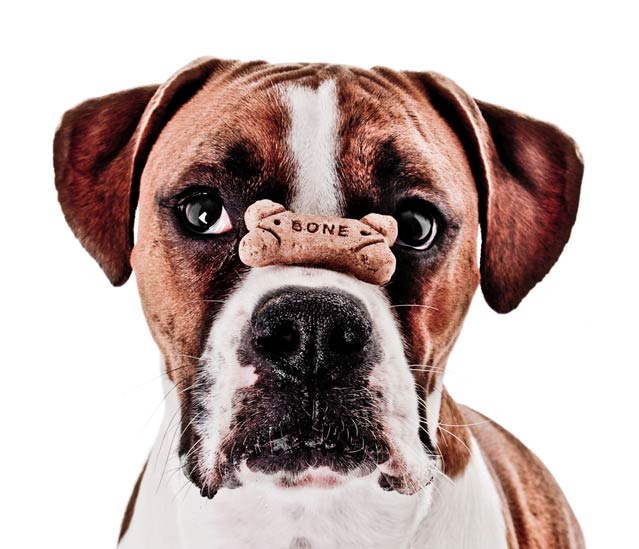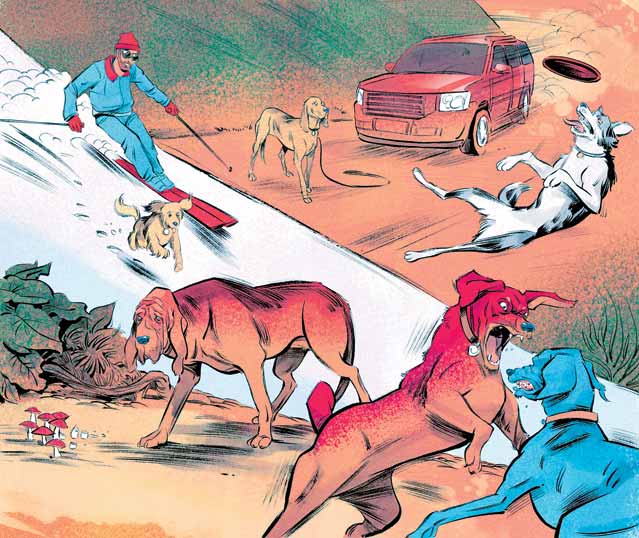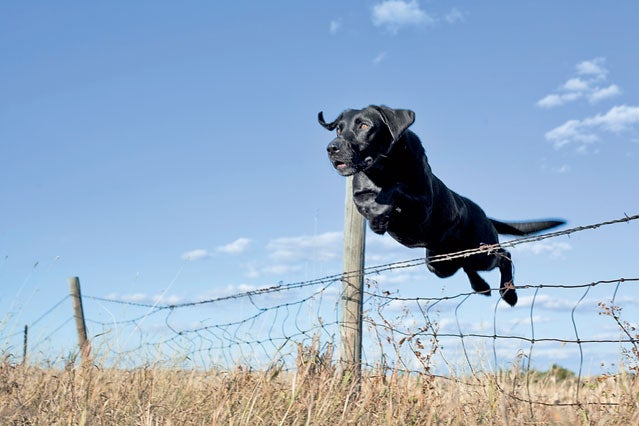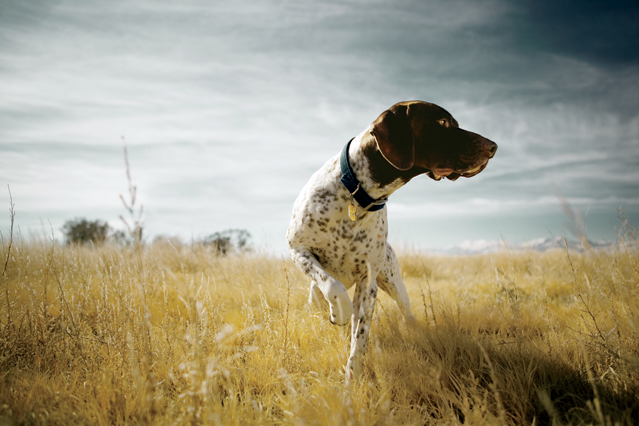From choosing the right breed to buying the right gear, here's what you need to know.��
���ϳԹ��� Training 101
- When you're packing into a campsite, your dog should carry its own food and water. If you're in a leave-no-trace area, it should also pack out its own waste.
- Which reminds us: pick up your dog's poop anytime it's visible from the trail.
- Dogs generally overheat much faster than humans. If you're hungry or thirsty, chances are your dog is, too.
- You aren't the only one who can get injured. If you're headed into the backcountry, pack a pet first-aid kit.
- If the terrain you're trekking through is rough and jagged, check periodically for cuts and scrapes on paws. Spray-on remedies, like Pet Care's Liquid Bandage ($7), work well in a pinch.
- If your dog comes when it's called within two commands, doesn't chase wildlife, and never jumps on or runs directly at other people, it can be off-leash. Otherwise, keep it tethered.
- It's never too late to train your dog.
Pick the Right Breed

Australian Shepherd
- Type: Cattle dog
- Personality: Exuberant, bold, brave
- Pros: Aussies are independent thinkers with no real chase instinct (they work herds by staring them down, not nipping). That makes them good companions for dynamic, fast-paced activities.
- Cons: High-energy; heavy shedders; thick coats prone to burs and matted fur (but also resistant to brush, thorns, and water)
- Best Suited To: Hiking, running, skiing, kayaking, and especially mountain biking
- Similar Dogs: Border collie, blue heeler
British Labrador Retriever
- Type: Sporting dog
- Personality: Friendly, loyal, affectionate
- Pros: America's most popular dog is trainable, loving, and social. British labs are generally smaller and leaner than their American cousins and are thus better adapted to endurance sports.
- Cons: Can put on weight if they don't get enough exercise; not the fastest dogs around, but will run until they drop; hip dysplasia
- Best Suited To: Most sports, particularly boating: they're excellent swimmers
- Similar Dogs: Chesapeake Bay retriever, golden retriever��
Siberian Husky
- Type: Sled dog
- Personality: Smart, stubborn, occasionally aloof
- Pros: Strong, tough, and durable, Huskies are bred to pull sleds over long distances. Given the right conditions, they'll work forever. You'll have a hard time finding a better dog in the snow.
- Cons: Prey driven—will chase virtually any animal that crosses their path; can be destructive if left alone; prefer cooler weather; tend to bark a lot
- Best Suited To: Skiing, snowboarding, snowshoeing, hiking, and mountaineering
- Similar Dogs: Alaskan malamute, Samoyed, chow chow
English Setter
- Type: Hunting dog
- Personality: Affectionate, happy, almost goofy
- Pros: Athletic and motivated, with a deeply ingrained hunting instinct, setters are gentle and tolerant—and they're great with kids.
- Cons: Birding instinct is so hard-wired that it can be difficult to work around when training; affectionate nature can make them sensitive; fairly heavy droolers
- Best Suited To: Running, hiking, boating, and hunting
- Similar Dogs: Irish setter, springer spaniel, German shorthaired pointer
Poodle
- Type: Water dog
- Personality: Friendly, playful, obstinate at times
- Pros: Extremely smart, poodles are also solid swimmers, are comfortable around guns, shed minimally, and are hypoallergenic. The largest size—standard—is the best bet for rugged outdoor pursuits.
- Cons: Energetic and prone to boredom if you don't keep them entertained; can be mischievous
- Best Suited To: Hunting, fishing, and boating
- Similar Dogs: Portuguese water dog, Irish water spaniel
*Mutts are also a good option. Breed characteristics will still be apparent, however. Choose a mix that fits your lifestyle.
There Are No Unteachable Dogs

First know this: dogs don't sit, stay, or heel because they think it's the right thing to do. They do it because those habits have been ingrained through training. Here are the basic principles: command, behavior, mark, reward. Every time your pup sits, say “good” and give it a treat, either a small piece of food (liver treats or popcorn are good) or a pat on the head. By saying “good,” you're marking the behavior: your dog will quickly realize that “good” means food or attention. Eventually, it will realize that every time it sits, it gets a “good” and then a treat. At that point, add in “sit.” Before long it will all come together: “ 'Sit' (the command) means I should sit (the behavior), because that means I'm going to get a treat (the reward).” It's a simple formula, but it's also the most fundamental one. From there you can move on to “here,” “heel,” “leave it,” “down,” “beer me,” and all the other crucial commands.
Prevent the Most Common Injuries

Ski edges (11%): Avoid slicing your dog by bringing it only when you cross-country or skate-ski. (Most nordic skis don't have edges.)
Poisonous plants (11%): Dogs that forage aren't getting a proper diet. Feed your dog grain-free dog food (no corn or gluten). It's more expensive but healthier.
Cars (18%): Use rewards to train Fido to do two things—to come when called and to heel on command, especially at trailheads and intersections. If your dog is at heel and you stop, it should stop, too.
Exercise injury (29%): To avoid ACL tears and other mishaps, feed puppies food with a protein-to-fat ratio of about two to one, for bone and joint development, and keep hikes longer than two miles to a minimum.
Dogfights (19%): Get your puppy used to unfamiliar dogs. Talk to and shake hands with another dog's owner, demonstrating that the two of you are in charge, then tell your dog, “Go say hello.”
Follow These Sport-Specific Tips for Worry-Free Play

Mountain Biking:��Your dog should be a running breed (pointer, heeler, husky) and in good shape. Otherwise joint damage and arthritis could be in its future. Train your dog to follow two feet behind your rear wheel. And if you're riding hard or bombing steep descents, leave it at home.
Trail Running:��The key is good recall—your dog's ability to come back to your side on command. Train your dog to recall at a turn in the trail, so it doesn't encounter something before you do. If it gets excited when you come upon other runners or dogs, train it with the command “leave it.”
Whitewater Rafting:��Stick to mellower stretches of water (generally, nothing over Class III), get your dog a flotation device, and designate a spot for it to sit. Create a target in the boat (a life jacket or a dog bed) and repeatedly lead your dog to it, rewarding it when it stays. Familiarize your dog with currents by playing ball in the eddy line. For more tips and trip ideas, check out .
Backcountry Skiing:��Skis have razor-sharp edges that can cut pups' tendons. Your dog should be able to heel at least two feet behind you on the way down—or wait at the top of the hill until you've descended before following. And get dog booties: snow can cause your dog's pads to abrade to the point of bleeding. Get your dog used to wearing them by putting them on at feeding time for a few weeks before heading out. Our testers' favorites: Bark'n Boots Grip Trex ($70).





